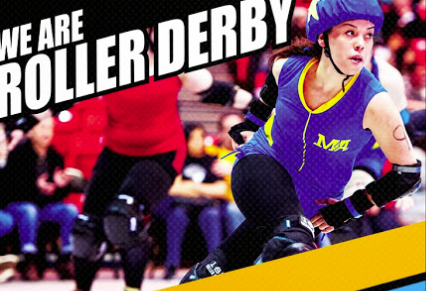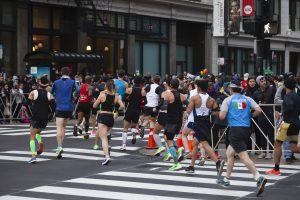The All-Stars, one of three travel teams within the Windy City Roller’s league, circle the practice derby track donned in black muscle t-shirts and scuffed skates from vigorous drills and bouts-the high-adrenaline, fan-packed derby games held in the UIC pavilion.

A whistle blows. Their knees lifts to their chests, right leg, left leg, repeating again and again until they make it across the track in unison. Once they make it to one side they are split into two groups.
Both groups have a jammer, the skater who during a bout has a star helmet cover and scores all the points for her team and in doing so earns the Lead Jammer status. One of the jammers is less than 5 feet tall, which comes to her advantage when she has to swerve through the opposing team’s pivot-the skater that sets the pace of the pack & is often called the “last line of defense” -and three blockers.
She waits for the whistle.
She stands a few feet behind the group, knees slightly bent, her elbows tucked into her side, her palms facing each other suspended in the air. The whistle blows. Her body lurches forward and she skates towards the pack.
The gym echoes with squeaks and thumps of skates hitting the track as the blockers shuffle back and forth to stop her from getting through. The jammer gets in the middle of the pack and pivots back and forth looking for an opening, but the group stays shoulder-to-shoulder, arm-to-arm. They call out to each other “move left” or “close right.” The jammer smirks, her eyes shift quickly, spotting an opening; she fakes left and escapes the open space on the right then skates triumphantly around the track.
Among the group of women is a skater who has been with All-Stars for the past year. She skates under Moby Nipps, a nickname that has stuck on and off the track, which is the case for most women in derby.
To the spectator, these women are entertaining, their nicknames are catchy, and derby is pretty badass. All valid points, but what people outside of derby don’t get to see is the athleticism and hard work behind the spectacle.

“Its insanely intense right now, we are in the last few weeks,” says Nipps. “We have 4-5 practices a week, we have off–skates conditioning with a trainer who is coming in our space and killing us for half an hour and then we are putting on skates while our muscles hurt and trying to push through.”
This practice is a different scene from the last bout of the home season that happened on Saturday night. Surrounded by screaming fans, alumni and stage lights, the women are amped up, wearing face paint and screaming alongside the track, some wearing colorful socks and frilly back pieces. What goes on behind the scenes is what really makes the women of WCR real athletes. Still, the idea that derby could actually be a sport first and entertainment second isn’t something the media has caught on to.
The women of today’s league are trying to display themselves in a different light. They are athletes and they are out to prove it. Whether or not the WCR decides to pull away from nicknames, a tradition that has continued since derby’s inception, they will still be on this practice track, at cross-training, doing off-skates workouts, clocking in volunteer hours and more to prove they are real athletes, and the nicknames aren’t going to change that.
“Derby was different back then,” says Nipps. “It was like, you go to practice and then you go out drinking all night. It didn’t have the same competitiveness that it does now.”
Just a week before Nipps was doing her part of volunteer work in the same practice space. She was coaching the Haymarket Rioters (HMR) – the league’s farm team and one of five home teams. The HMR are a team that requires newcomers and transfers to try out and get their skills up to par before they are drafted onto a home or travel team. But don’t be mistaken – even on its lowest level, the women of derby work hard.
The HMR are practicing stopping drills.
They line up on the side of the track and one by one skate towards an orange cone swinging themselves to a stop on the tips of their skates like ballerinas “en pointe,” their calves bulging out of their black leggings. Every so often a girl hits the floor with a loud thump, gets up quickly and skates back into line to do the drill again. Nipps skates along the side, watching. In derby, being in control of your body and keeping your balance is key, something Nipps herself took some time to learn.
“I was like school of hard knocks,” says Nipps, who started off knowing only how to rollerblade. Nipps sits in a chair angled towards the track with her bent knees about a foot apart and her padded elbows resting on her inner thighs as if she is still skating. The ends of Nipps short brown hair are dripping with sweat, her cheeks blushed red. Her breathing slows to a normal pace as she settles into her chair. This is not even her practice but she works just as hard.
And the hard work pays off, but not without sore hamstrings, abs, and a few strained muscles along the way. No skater she knows has come out of derby without at least one injury.
“We all call it our abusive relationship,” Nipps says. “It’ll beat you up…and we all come back to it.”
From an outsider’s perspective, it’s easy to understand why derby could just be another exciting event to watch, but nothing worth covering consistently. On the track the audience is kept on the edge of their seats watching all the bumps, bruises, sweat, and an occasional up-chuck occur just feet away. In the practice gym, all of above can happen, but add in drills, playbooks and scrimmages and you have four hours of work and play.
“If they come to our practices they’ll see we are strategizing, we watch hours of footage, we want to be better, and we are constantly competing,” says Janicide Joplin, a skater for The Fury – one of five home teams – and the All-Stars.
At least five students covered the bout at Saturday night’s last home bout of the season, two photographers and a couple of videographers interviewing passing skaters, but it wasn’t like watching Bulls game that is heavily covered by sports news outlets.
One fan describes “the wild atmosphere” of the bouts she experienced saying that she couldn’t tell who was having a better time, the derby girls or the spectators.
“It’s got the same kind of crowd as a huge NFL game, just in much smaller proportions,” says Jessica Dumbroff, a 22-year-old speed skater from Naperville.
There is seemingly only one reporter who recognizes the need for mainstream coverage. Bill Mayeroff, a sports writer for Chicago-based web publication Gaper’s Block, has become one of the only writers that consistently covers the Windy City Rollers. And unlike the short–lived feature articles in the entertainment section of other major news outlets, Mayeroff’s articles are in the sports section.
“The bout recaps that I have done, they are like any story that would be about a baseball game or a basketball game that you would see in the sports pages of any newspapers. That is how I report it. It’s like any sports news story,” says Mayeroff.
He has covered Chicago derby for the past year, and before that covered derby in Western Illinois, where he says he couldn’t convince the sports editor at the newspaper to put derby in the sports section.
“For the most part, in the major news media outlets the perception is still that roller derby is less sport and more entertainment,” says Mayeroff, who attributes this perception as the reason media coverage is basically non-existent.
As for derby names, Mayeroff says that as a journalist he has always been taught to use legal names, so he asks why derby is the exception in this case. He proposes that this could be another reason derby is looked at differently: because it chooses to be different than mainstream sports.
“Roller derby is the only sport where players regularly play under some kind of nickname or pseudonym,” says Mayeroff. “How derby coverage would change if they started using real names? I can’t say, but I don’t think it would hurt derby coverage in the city if they started using their real names.”
Mayeroff says that derby’s minimal coverage, however, is not because of their lack of trying.
Emily “Karmageddon” Cromwell, Women’s Flat Track Derby (WFTDA) Representative agrees, saying WCR has reached out for more coverage countless times.
“It’s hard to get good coverage in a city like Chicago, where we have more pro sports teams than some states,” says Cromwell.
The WFTDA was formalized in 2004 with the goal of formally uniting derby leagues across the nation as well as to change the image of the skaters. The new governing body wanted its women to be seen as “world-class athletes.”
“Roller derby started as something alternative and fun, but as we all started taking it more seriously and wanting to be the best, that required more athleticism and less spectacle,” says Cromwell.
Derby has been around since the mid 1930’s but it didn’t resurface until 2001, when a group of women in Austin, Texas, working at four different bars, decided to host a women’s flat track roller derby bout. Allegedly, the team themes were based on the bar’s decor and were represented in each team’s handmade uniforms. This established the sexy pin-up and punk roller derby looks and led to the stigma that roller derby is more for show.
Cromwell explains that this change from theatrical to serious has been gradual but in line with the expectations the WCR sets for itself and correlates with the league’s continued push for media coverage.
“The way we will get coverage is to just keep infiltrating and having a product that people want to watch, attend, and follow.”
Mayeroff says he sees teams like WCR and the Chicago Outfit leading by example as the leagues that are on the way to being taken seriously because they are pulling away from the theatrical aspects of the sport.
But there are still teams that decide to add a little more flair to their uniforms, wear colorful knee-high socks or exaggerated makeup and this, Mayeroff says, could be a reason why media outlets won’t cover it consistently.
“Don’t get me wrong, there is always room for our athletes to add some attitude to their uniform; maybe some fancy leggings or awesome socks to add some personality, but once you dig those cute fishnets out of your skin because you took a bad fall and somebody rips your cute skirt off during a whip, you might choose to wear something more serviceable and save your flair for the after party,” says Cromwell.
Regardless, these women are proving bout by bout, that they are dedicated, serious athletes who, like most professional athletes, would do anything for their team. Joplin is one of those women.
“You got to be able to go out there, for nine jams in a row on a sprained ankle, and keep playing,” says Joplin, a mother of two.
That is exactly what she did. For this year’s Ivy King cup, Joplin sprained her ankle in the first turn of the first jam. She sat down to get taped up, took some painkillers, went back out on the track and never sat back down.
“People don’t see what goes into this, my family included,” says Spartakris, skater for The Fury & Third Coast. “I tell them I am going to play roller derby and they picture a WWF style match.”
Although media outlets have realized that derby isn’t a fake-contact sport like professional wrestling, Matt Veto, a sports reporter, says the similarities between the two have put derby out of reach.
“I don’t think that if you asked a sports writer why they don’t cover derby that theirfirst answer will be ‘no because its like professional wrestling,’” says Veto, who believes the sports showmanship draws a direct coupling to something like professional wrestling.
Veto says he sees derby as a sport because he defines a sport as a “competitive, energy exerting, physical activity,” but the reality is that mainstream media has carved out a niche for what they regularly cover, and that is going to be hard to break.
“I think if you were to say, drop the costumes, drop the names, make yourself available as people to the sports writers as people off the track, then people outside of derby would say they are athletes,” says Veto.
The media hasn’t caught wind of the shift that Cromwell mentioned – the move from spectacle to sport that everyone in the derby community can see clearly. Still, Veto says, the process of breaking down an already set way of sports coverage is not an easy task.
“Even then the sports writers would ask if we start covering this, then what else to do we have to cover, do we have start covering bowling, the billiard tournaments? How do we rationalize that to the public?” says Veto. “It’s a can of worms that a lot of people don’t want to open.”
The rationalization is in the work that these women do every year to win bouts and compete countrywide. Legal Tenderizer, skater for the home team Second Wind, sits in a folding chair in front of the track watching Nipps continue to coach. With her legs spread forward, hands in her zippered sweater pocket, she says she promises it is harder than it looks.
Legal wonders out loud whether this is how she looked when she started out in the Rioters about a year ago. Now she puts in an average of 10 hours a month of volunteer work for the league, skates and trains for Second Wind and home team Hell’s Belles, and works as a paralegal outside of derby.
Everyone in derby volunteers – Rioters, home team members, and travel team members. There is no lack of worth ethic in this league. Legal has experience in every aspect of derby.
“I was one of the better skaters on [Aurora 88’s] A team. When I came in as a Rioter I was definitely at the bottom of the totem pole,” says Legal, “I started going to every practice I could and doing everything I could off skates. There were some days I did triples, I would do crossfit, another off skate workout, and have practice the same day.
Legal says she may have overdone it, but she wanted to be at the top of her game. Her drive hasn’t changed and she is ready for the last bout of the home season on Saturday, where she and Nipps will be putting all their hard training to work.
On Saturday, Nipps and Legal are surrounded by the stands of the UIC pavilion. The stands are starting to fill as well as the front row seats that circle the track. The lights turn a brighter yellow as Nipps and Legal disappear into a crowd of skaters and alumni.
Mack Savage, skater for the home team Manic Attackers, bounces into view. But she is not skating tonight; she is the “Media Mistress,” just one aspect of her volunteer work for WCR. She adjusts her gray beanie over her curled caramel hair so it’s in line with her black-rimmed hipster glasses and walks with purpose around the track, student media in tow.
Nicknames and theatricality aside, Mack thinks the hard work and training that goes into derby should be proof enough that it is legitimate. She lost 13 pounds unintentionally since starting derby. Her journey started at Derby Lite – a beginner’s speed skating class and crash course to derby. She went from one-hour practices to two to four practices when she came to WCR.
“I got into it originally because I thought it was cool,” says Mack. “Now I can’t imagine life without it.”
Like Legal, Mack went through the Rioters program and was drafted onto a home team, where she says she went from practicing with women at her own level to practicing with women who had been skating for seven plus years.
Mack says now she goes from her nine to five Project Management job, home for a quick meal and then straight to practice. Assuming that the practice goes flawlessly, it last two hours, but nine times out 10 they will be there for at least four.
Mack questions why the mainstream media hasn’t latched on to this sport because she feels they have done everything in their power to market themselves as athletes. She points out that like professional sports teams, each team in Windy City Rollers sponsors a charity.
Minerva Damage, WFTDA board member, put it best; derby is at a fork in the road.
“Roller derby is at a crossroads now between putting its past to rest and moving forward without ties to theatrical derby of yesteryear,” says Damage.
For now, WCR will keep the infamous derby names in hopes that the media will look beyond them and see that derby isn’t the campy, cool thing to do on the weekend anymore.
WCR reaches out to media outlets every year for coverage and promises that people will see why they should be put in the same caliber as athletes as they consistently kick ass and take names.
Back on the track in the UIC pavilion, the speaker blares announcing the beginning of the first bout, Second Wind versus the Killamazoo Derby Darlins of Michigan.
“Are you ready for some derby?”
The crowd cheers. Second Wind skates out, donned in teal jersey-like tops with their names printed in white letters on the back and matching shorts. An announcer dressed in a white suit made up of a vertical Chicago flag announces each player’s derby name. Legal Tenderizer, number 55, skates ahead as her name is announced, her short curly hair blowing behind her.
All the hard training pays off. Second Wind beats Killamazoo 246-129.
Then it’s the All-Stars turn, and the pavilion vibrates with stomping feet, clapping hands and screaming voices as the women skate onto the track, dressed in black and silver uniforms with a silver number printed on their back, ready to face the Detroit Derby Girls.
They carry the Chicago flag, which catches the wind beneath it and spreads open for the crowd to see as they skate into a huddle, locking their arms around each other. The bout begins, with All-Stars’ jammer pushing her way through the pack with swift movements left and right. She looks for an opening, finds one and skates through. She skates around the track, a gust of wind passing through the front row seats.
Another sweeping defeat ending in 240-127, with the All-Stars taking home the win.
Other CT stories about the Windy City Rollers, Talk Derby to Me


















Be First to Comment